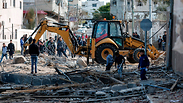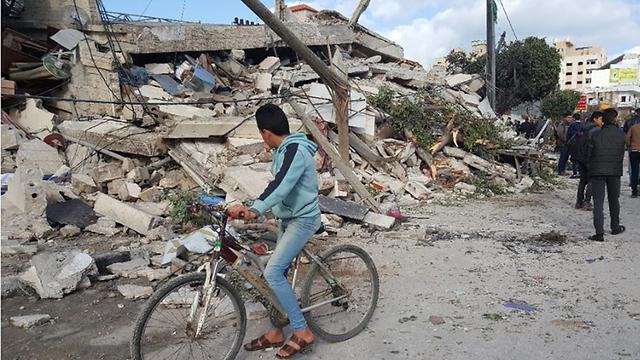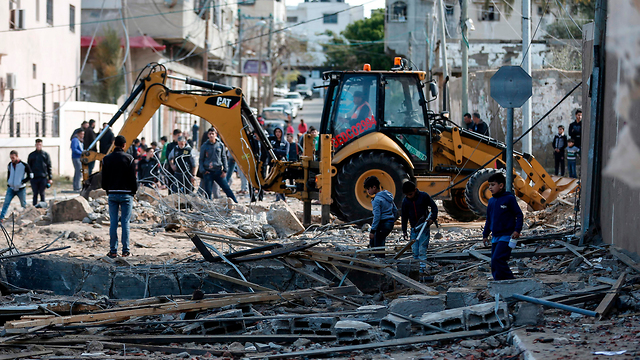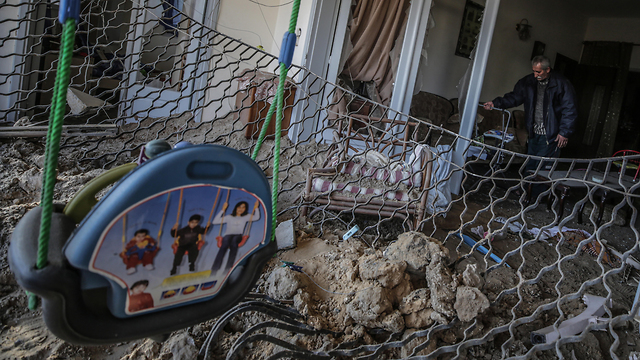
IDF playing the same old game in Gaza
Analysis: With elections, Eurovision and Passover looming, the army has a limited timeframe for its current operation against Hamas; so instead of taking a bold step to change the situation on the ground, it finds itself trying to achieve limited goals that look good in pictures
And so we can already say that the IDF was not dispatched on a military operation to replace the Hamas regime in Gaza. As such, the political leadership's directive to the army has been and still remains to push Hamas back into a weakened state - deterred, but still in charge in Gaza. To achieve this objective, the army has to erode the military capabilities of both Hamas and Islamic Jihad.
The desired objective is several years of calm along the Gaza border, more than the three years of quiet following the 2014 war against Hamas. Is the army going to implement such a plan in the coming days? It's doubtful.
Such an objective would require an operation lasting several weeks. But does the political echelon really have several weeks, on the eve of elections, on the eve of the Passover holiday, and on the eve of the Eurovision?
For the past three years, the IDF has been preparing for the fourth operation against Hamas since it came to power in 2006. Over the past year, under the leadership of GOC Southern Command Herzl Halevi, a unique combat doctrine has been formulated to deal with the need for prolonged control of the Gaza Strip as a result of military action.
This combat doctrine was translated into an operational program for land and air. When Chief of Staff Aviv Kochavi took office, preparations for the destruction of Hamas' military power became the central preoccupation of the IDF.
Kochavi's situation assessment has determined that it will happen this year. Over the past 12 months, Israel has conducted 11 rounds of fighting against Hamas. The tension on the fence only increases and the General Staff came to the conclusion a few months ago that going to war could serve as a strategic warning.
The operation, however, has begun sooner than Israel estimated, and in inclement weather that is less convenient for achieving the IDF's goal of destroying Hamas' military force without collateral damage.
Given that the elections, the Eurovision and the Passover holiday are liable to dictate the army's timetable, the operation could end as merely another round of major pyrotechnics with glorious photographs of the bombed-out Hamas leadership, while actually having to make do with very limited goals.
Indeed, the potential mission could take one of several forms - from the IDF concentrating its focus on a ground operation involving reservists, to an operation based mainly on the regular army, which has been training for this for more than a year, to a solely aerial operation.
Former defense minister Avigdor Lieberman once recommended to the cabinet that Israel implement a plan that was primarily based air strikes, which he claimed would have brought calm to Gaza for years. The cabinet rejected this.
According to the IDF Spokesperson's Unit, the Southern Command will be reinforced by two regular brigades and a divisional unit that is ready to absorb additional force, fighting alongside the Gaza Division. This deployment signals that this round of fighting will be heavily based on air force strikes. But will such air strikes be halted after a day or two, due to international pressure, bringing yet another round of fighting an abrupt end without any real results, or substantial damage to Hamas' forces?
The rocket strike on the Sharon region hints at the potential for a real deterioration, as Hamas and Islamic Jihad possess dozens of self-produced projectiles capable of hitting Ben-Gurion Airport and harming Israel's aviation links with the rest of the world.
But if Hamas chooses this route, it will find itself under Israeli military attack from both air and ground that could last for weeks. The General Staff also realizes that in order to remove such a threat to the home front - and as quickly as possible - it is necessary to enter enemy territory and destroy it.
Hamas currently has about 5,000 rockets and Islamic Jihad about 8,000. The two organizations could fire hundreds of rockets a day, as well as mortar fire at the surrounding communities and the forces deployed in the south. During the 2014 war, they fired an average of 170 rockets a day for 51 days, and they now have greater capabilities than they did five years ago.

Hamas has a rocket that is essentially an explosive barrel. Known as the Thunder, it has a range of 5 kilometers and a 400kg warhead designed to penetrate the reinforced roofs in the Gaza border communities.
Hamas forces operate within five or six divisions, composed of more than 20 battalions. It has about 30,000 active fighters and another 7,000 in reserve. It is this power that Israel wants to strike, in order to weaken the organization's rule.
To do this, the IDF would also have to deal with 6,000 Islamic Jihad fighters. Hamas is equipped with dozens of anti-tank rockets, unmanned aerial vehicles and advanced underwater equipment. It also has an organized plan of fire against the Israeli home front and an underground defense system that would present a challenge for any force that tries to invade the Gaza Strip.
Does the IDF intend to deal with the operational challenges that Hamas has created, or will it be satisfied with a large punitive operation based on striking attractive targets such as high-rise buildings and Ismail Haniyeh's office? If the social media posts from Gaza are any indication of the mood of the local population, it seems there is no great love for Hamas' activities there.
They also cannot understand what the organization is doing, and are waiting for the Egyptian delegation of mediators, which has been in Israel for two days, to return to Gaza and bring the quiet with them.













